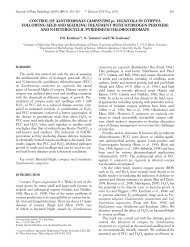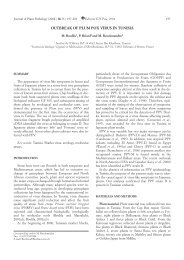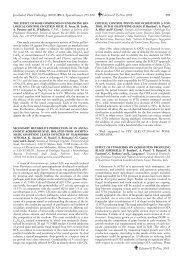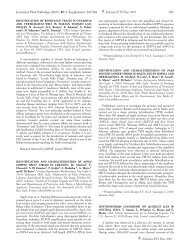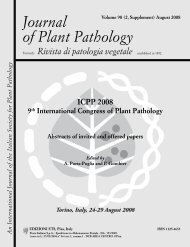Journal of Plant Pathology (2010), 92 (4, Supplement ... - Sipav.org
Journal of Plant Pathology (2010), 92 (4, Supplement ... - Sipav.org
Journal of Plant Pathology (2010), 92 (4, Supplement ... - Sipav.org
Create successful ePaper yourself
Turn your PDF publications into a flip-book with our unique Google optimized e-Paper software.
<strong>Journal</strong> <strong>of</strong> <strong>Plant</strong> <strong>Pathology</strong> (<strong>2010</strong>), <strong>92</strong> (4, <strong>Supplement</strong>), S4.71-S4.105 S4.101<br />
concentrations (2% w/v). Proteome maps <strong>of</strong> extracellular proteins<br />
<strong>of</strong> T. versicolor grown in two conditions, supporting or not<br />
the production <strong>of</strong> bioactive proteins, were analyzed by 2D gel<br />
electrophoresis identifying spots with qualitatively and quantitatively<br />
differences between the two growth conditions and subsequently<br />
characterised by MALDI-TOF. These results might be<br />
promising in view <strong>of</strong> the application <strong>of</strong> a more environmentally<br />
friendly strategy aimed at achieving an improved control <strong>of</strong> the<br />
different toxins which are <strong>of</strong>ten present in foods and feeds.<br />
INTRASPECIFIC VARIABILITY OF ERWINIA AMYLOVO-<br />
RA STRAINS FROM MOROCCO. G. Scuderi 1 , F. Valentini 2 ,<br />
C. Platania 1 , A.M. D’Onghia 2 , M. Fatmi 3 , G. Cirvilleri 1 . 1 Dipartimento<br />
di Scienze e Tecnologie Fitosanitarie, Università degli Studi,<br />
Via S. S<strong>of</strong>ia 100, 95123 Catania, Italy. 2 Centre International de<br />
Hautes Etudes Agronomiques Méditerranéennes, Mediterranean<br />
Agronomic Institute <strong>of</strong> Bari, Via Ceglie 9, 70010 Valenzano (BA),<br />
Italy. 3 Département Protection des <strong>Plant</strong>es, Institut Agronomique<br />
et Vétérinaire Hassan II, Complexe Horticole d’Agadir, Morocco.<br />
E-mail: gcirvil@unict.it333<br />
Fire blight disease, caused by Erwinia amylovora, detected for<br />
the first time in Morocco in 2006, has spread rapidly throughout<br />
the main orchards areas. Surveys were carried out in these regions<br />
to evaluate the current situation <strong>of</strong> the disease in the country. In<br />
2009 the disease was observed in 71 farms <strong>of</strong> different regions, i.e.<br />
Meknes, El Hajeb, Sefrou, Ifrane, Taounate and Khenifra. In<br />
terms <strong>of</strong> infected area, more than 720 ha were recorded in 2009.<br />
To date, over 215 ha <strong>of</strong> pear, apple and quince have been destroyed<br />
(dug out and incinerated). A collection <strong>of</strong> 48 isolates obtained<br />
from pear, apple and quince trees showing clear-cut fire<br />
blight symptoms in 2006 and 2009 were identified as E. amylovora<br />
using morphological, biochemical and serological tests. In addition,<br />
classical PCR and real-time PCR were used to confirm identification.<br />
This collection <strong>of</strong> E. amylovora isolates and reference<br />
bacterium strains from several countries were examined by rep-<br />
PCR and fAFLP fingerprint. Bacterial strains showed 90% similarity<br />
in the rep-PCR analysis using ERIC and BOX primers. The<br />
fAFLP analysis with primer set MseI+C, EcoRI+A showed a higher<br />
variability than previously observed, allowing the differentiation<br />
<strong>of</strong> all E. amylovora strains, even if no clear grouping <strong>of</strong> strains<br />
was possible in terms <strong>of</strong> correlation between isolates, host plant,<br />
year and country <strong>of</strong> isolation. In this study fAFLP analysis proved<br />
to be the most useful tool for discriminating among strains <strong>of</strong> E.<br />
amylovora from different hosts and years <strong>of</strong> isolation.<br />
IDENTIFICATION AND PATHOGENICITY OF BOTRY-<br />
OSPHAERIA spp. ASSOCIATED WITH GRAPEVINE<br />
TRUNK DISEASES IN SARDINIA. S. Serra, B. Scanu, A.<br />
Schiaffino, A. Deidda, B.T. Linaldeddu. Dipartimento di Protezione<br />
delle Piante, Sezione di Patologia Vegetale, Università degli<br />
Studi, Via E. De Nicola 9, 07100 Sassari, Italy. E-mail: salvase@<br />
uniss.it<br />
Grapevine spur, cordon, and trunk dieback constitute a serious<br />
economic problem in Sardinian vineyards. Recent studies<br />
have indicated that several grapevine trunk pathogens belong to<br />
the genus Botryosphaeria. Thus, during 2009 a field survey was<br />
carried out to study Botryosphaeria spp. involved in the aetiology<br />
<strong>of</strong> grapevine trunk diseases in several vineyards located in north<br />
Sardinia (Italy). Botryosphaeria spp. were the most common fungal<br />
species isolated from symptomatic tissues. Four species<br />
(Botryosphaeria australis, B. obtusa, B. parva and Lasiodiplodia<br />
theobromae) were identified on the basis <strong>of</strong> morphological and<br />
cultural features. The identity <strong>of</strong> B. australis was also confirmed<br />
by analysis <strong>of</strong> nucleotide sequences <strong>of</strong> the internal transcribed<br />
spacer region (ITS1-5.8S-ITS2) <strong>of</strong> rDNA. BLAST searches in<br />
GenBank showed 100% similarity with reference sequences <strong>of</strong> B.<br />
australis and confirmed differences in three nucleotide positions<br />
from sequences <strong>of</strong> Ne<strong>of</strong>usicoccum luteum, a closely related<br />
Botryosphaeria species. Pathogenicity <strong>of</strong> all species was assessed<br />
by inoculation <strong>of</strong> excised green grapevine shoots <strong>of</strong> cvs Vermentino<br />
and Cannonau under controlled laboratory conditions. B. australis<br />
and L. theobromae were more virulent than the other<br />
species. Inoculated fungi were successfully reisolated from all infected<br />
tissues, thus fulfilling Koch’s postulates. These findings<br />
confirm the active role <strong>of</strong> Botryosphaeria spp. in the aetiology <strong>of</strong><br />
grapevine trunk diseases. For each fungal species, except for B.<br />
obtusa, this represents the first record on grapevine in Sardinia.<br />
DIAGNOSTIC ANALYSES ON FOURTH RANGE PRO-<br />
DUCTION IN THE PROVINCE OF SALERNO. L. Sigillo, V.<br />
Senape, G. Serratore, V. Spina, R. Bravi. Ente Nazionale Sementi<br />
Elette, SS 18 km 77.700, 84091 Battipaglia (SA), Italy. E-mail:<br />
l.sigillo@ense.it<br />
The production <strong>of</strong> species for fourth range market has strongly<br />
increased in the last years. Important economical losses are reported<br />
due to the widespread pesence <strong>of</strong> bacterial and fungal diseases.<br />
In our laboratory, 73 samples <strong>of</strong> rocket (Dyplotaxis tenuifolia),<br />
65 <strong>of</strong> lettuce (Lactuca sativa), 19 <strong>of</strong> corn salad (Valerianella<br />
locusta), 9 <strong>of</strong> spinach (Spinacia oleracea) and many other minor<br />
species were analysed from 2005 to <strong>2010</strong>. Among these, 108 and<br />
68 seed and symptomatic plant samples were analysed for detection<br />
<strong>of</strong> the most important pathogens. Rocket seed samples were<br />
contaminated by Xanthmonas campestris (!5%) and pathogenic<br />
strains <strong>of</strong> Fusarium oxysporum (8%), Instead, 50% and 20% <strong>of</strong><br />
rocket plants were infected by F. oxysporum and X. campestris, respectively.<br />
F. oxysporum, Verticillium sp. and Rhizoctonia sp. occurred<br />
rarely on lettuce seeds or plant tissues (about 3%). Generally,<br />
corn salad, beet and spinach seeds were healthy. X.<br />
campestris was detected only in a sample <strong>of</strong> corn salad. In conclusion,<br />
an increase <strong>of</strong> F. oxysporum and X. campestris incidence on<br />
rocket has been observed in the last years. This increase is probably<br />
due to the diffusion <strong>of</strong> monoculture system and the use <strong>of</strong><br />
contaminated seeds in the fourth range production.<br />
DISTRIBUTION OF THREE DIFFERENT ISOLATES OF<br />
CITRUS TRISTEZA VIRUS IN SOUTHERN ITALY. G. Sorrentino<br />
1 , S. Davino 2 , M. Davino 3 . 1 CRA, Istituto Sperimentale per<br />
l’Agrumicoltura, Corso Savoia 190, 95024 Acireale (CT), Italy. 2 Dipartimento<br />
di Scienze Entomologiche, Fitopatologiche, Microbiologiche,<br />
Agrarie e Zootecniche, Sezione di Patologia Vegetale e Microbiologia<br />
Agraria, Università degli Studi, Viale delle Scienze,<br />
90128 Palermo, Italy. 3 Dipartimento di Scienze e Tecnologie Fitosanitarie,<br />
Sezione di Patologia Vegetale, Università degli Studi,<br />
Via Santa S<strong>of</strong>ia 100, 95123 Catania, Italy. E-mail: davino@unipa.it<br />
The discovery <strong>of</strong> large concentrations <strong>of</strong> different citrus<br />
species affected by the Citrus tristeza virus (CTV) in southern<br />
Italy has provided the opportunity for investigating the distribution<br />
<strong>of</strong> three main viral isolates. The survey was carried out in different<br />
farms mainly in the Baè area (Catania province). All trees<br />
in each area were sampled yearly from 2001 to 2008 in May and<br />
September. Four young apical shoots were collected and analyzed<br />
by DAS-ELISA or DTBIA. Molecular tests (SSCP and p20 and



